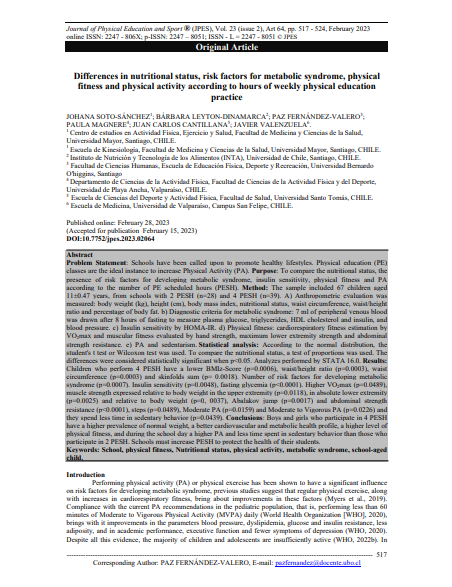Differences in nutritional status, risk factors for metabolic syndrome, physical fitness and physical activity according to hours of weekly physical education practice

Fecha
2023-02Autor
Soto-Sánchez, Johana [Centro de estudios en Actividad Física, Ejercicio y Salud, Facultad de Medicina y Ciencias de la Salud, Universidad Mayor, Chile]
Leyton-Dinamarca, Bárbara [Escuela de Kinesiología, Facultad de Medicina y Ciencias de la Salud, Universidad Mayor, Chile]
Fernández-Valero, Paz
Magnere, Paula
Cantillana, Juan Carlos
Valenzuela, Javier
Ubicación geográfica
Notas
HERRAMIENTAS
Acceda a títulos restringidos
¿Cómo descargar?Resumen
Problem Statement: Schools have been called upon to promote healthy lifestyles. Physical education (PE) classes are the ideal instance to increase Physical Activity (PA). Purpose: To compare the nutritional status, the presence of risk factors for developing metabolic syndrome, insulin sensitivity, physical fitness and PA according to the number of PE scheduled hours (PESH). Method: The sample included 67 children aged 11±0.47 years, from schools with 2 PESH (n=28) and 4 PESH (n=39). A) Anthropometric evaluation was measured: body weight (kg), height (cm), body mass index, nutritional status, waist circumference, waist/height
ratio and percentage of body fat. b) Diagnostic criteria for metabolic syndrome: 7 ml of peripheral venous blood was drawn after 8 hours of fasting to measure plasma glucose, triglycerides, HDL cholesterol and insulin, and blood pressure. c) Insulin sensitivity by HOMA-IR. d) Physical fitness: cardiorespiratory fitness estimation by VO2max and muscular fitness evaluated by hand strength, maximum lower extremity strength and abdominal strength resistance. e) PA and sedentarism. Statistical analysis: According to the normal distribution, the student's t test or Wilcoxon test was used. To compare the nutritional status, a test of proportions was used. The differences were considered statistically significant when p<0.05. Analyzes performed by STATA 16.0. Results:
Children who perform 4 PESH have a lower BMIz-Score (p=0.0006), waist/height ratio (p=0.0003), waist circumference (p=0.0003) and skinfolds sum (p= 0.0018). Number of risk factors for developing metabolic syndrome (p=0.0007). Insulin sensitivity (p=0.0048), fasting glycemia (p<0.0001). Higher VO2max (p=0.0489), muscle strength expressed relative to body weight in the upper extremity (p=0.0118), in absolute lower extremity (p=0.0025) and relative to body weight (p=0, 0037), Abalakov jump (p=0.0017) and abdominal strength resistance (p<0.0001), steps (p=0.0489), Moderate PA (p=0.0159) and Moderate to Vigorous PA (p=0.0226) and they spend less time in sedentary behavior (p=0.0439). Conclusions: Boys and girls who participate in 4 PESH have a higher prevalence of normal weight, a better cardiovascular and metabolic health profile, a higher level of
physical fitness, and during the school day a higher PA and less time spent in sedentary behavior than those who participate in 2 PESH. Schools must increase PESH to protect the health of their students.
URI
https://repositorio.umayor.cl/xmlui/handle/sibum/9408https://www.efsupit.ro/images/stories/februarie2023/Art%2064.pdf
https://doi.org/10.7752/JPES.2023.02064
https://dataciencia.anid.cl/article/299343
Coleccion/es a la/s que pertenece:
Si usted es autor(a) de este documento y NO desea que su publicación tenga acceso público en este repositorio, por favor complete el formulario aquí.